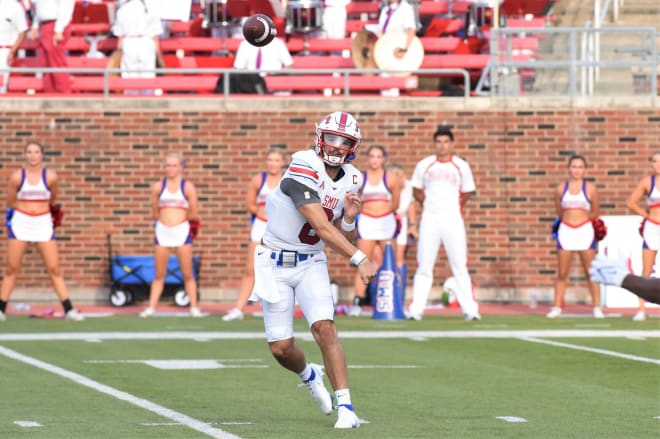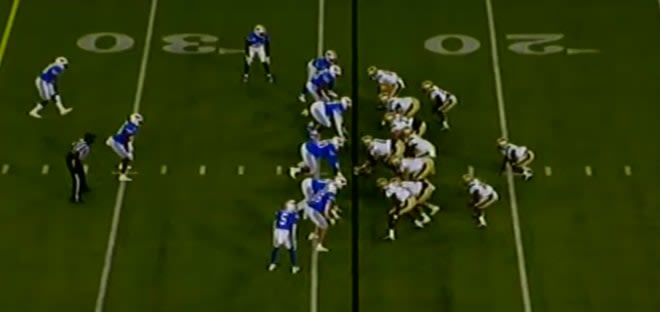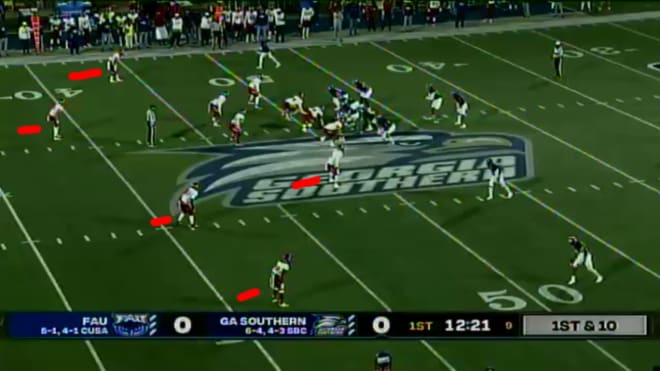The Navy-SMU Preview
If you've been a reader of this site for any length of time, you're probably very aware of what I've felt the Navy offense's problems have been in recent years. I thought that the team had bitten off more than it could chew; that by doing more on offense, they had gotten worse at the basics. Before anything else, Navy has to be flawless when running the option. This is especially true when you are deciding between two sophomore quarterbacks and have an offensive line that is the second least experienced in the FBS. Now isn't the time for Navy to work on anything else.
After the Air Force game, Ken Niumatalolo's comments seemed to indicate that he saw things the same way. The problem, though, is that these fundamentals are usually established in the spring and fall camp. Given the different nature of practices during the season, I wasn't sure how much could change this year. But the Mids were fortunate to have a bye week before the Houston game. Was that week spent in a more camp-like atmosphere? I don't know. However, I do know two things: 1. Navy has indeed taken a more back-to-basics approach over the last two games, and 2. it's working.
Navy jumped out to a lead in the first half against Houston but couldn't hold on in the end. Against UCF, the Navy offense put together a 60-minute performance. It wasn't without mistakes; the Mids fumbled the ball twice and had costly penalties. Nevertheless, they were able to move the ball. Navy put together five drives of nine or more plays, including one 14-play drive and one marathon 16-play drive. They had five such drives against Marshall too, but only one of them ended in points. The Mids scored on four of those long drives against UCF, and they went 5-5 in the red zone.
That's a crucial development, because if Navy wants to beat SMU this week, they'll need more of the same.
Under Sonny Dykes, the 24th-ranked Mustangs have carved out an identity as one of the country's most prolific offenses. They were 12th nationally in total offense (494.5 ypg) and 15th in scoring offense (38.6 ppg) last year while being equally adept at both the run and the pass. They set their school record for total offense in 2020 and scoring offense in 2019. They won ten games in 2019 for the first time since 1984 and spent eight weeks in the AP Top 25 poll, climbing as high as 15. Last year, they spent five weeks in the polls in an abbreviated season. They may not get the hype that other teams in the American do, but SMU has become one of the most consistently good teams in the conference.
Dykes’ 2019 squad hit a snag against Navy, though. The Mustangs fell to the Mids, 35-28, in a pivotal, late-season AAC contest. Relatively speaking, SMU’s offense was held in check, gaining only 251 passing yards along with a little more than half of their season average on the ground (93 yards). The 344 total yards and 28 points were both season lows. Navy made plays on defense, of course, but the biggest factor in slowing down SMU was Navy’s offense playing keep-away. Navy ran 88 plays to SMU’s 56 and held the ball for nearly 20 more minutes. The Mids had four drives of ten plays or more. SMU had four drives that lasted less than a minute.
In the past, volume has been the secret to SMU’s success. Their offensive numbers are always impressive, but they've been misleading at times. When you look at stats that measure efficiency— things like yards per play and third-down conversions— SMU hasn't always stood out. But efficiency isn’t their goal; Dykes is all about generating as many opportunities as possible. His team plays at an extremely aggressive pace; they are averaging 77.4 plays per game this season. The more chances they get, the more they score.
This year, though, SMU is doing it all. The Mustangs are fifth in the country in total offense, averaging a massive 532.4 yards per game. They are scoring 42.6 points per game, which is seventh in the country. Unlike past seasons, though, they are also in the top 20 in yards per play, plays of 20+ yards, and third-down conversion percentage. As a result, Dykes' squad is 5-0 for the third straight season, has earned a second consecutive win over rival TCU, and is ranked in both polls. Offensively, this is the best SMU team that Navy will have faced since joining the American Athletic Conference.

So why is SMU's offense so good this year? The scheme hasn't changed. The players, though, are as talented as any offensive unit in the league.
Any concern there might have been following the departure of quarterback Shane Buechele has been quelled by the performance of Tanner Mordecai. The Oklahoma transfer has been an absolute juggernaut, averaging nearly 314 passing yards per game. He already has 24 touchdown passes, five more than anyone else. If the season ended today, he’d be sixth on SMU’s single-season TD pass list. Mordecai has twice been named the AAC offensive player of the week this season, with the last award coming after throwing for 395 yards and five TDs against Louisiana Tech.
Mordecai is far from alone. The wide receiving corps is among the best in the country, one of three with at least 22 catches by three different players. All five starters on the offensive line are back from last year, including two all-conference selections on the left side. They have yet to give up a sack this year. They also pave the way for Ulysses Bentley IV, a Freshman All-American in 2020 after rushing for 913 yards and 11 touchdowns. He ran for 153 yards against TCU. SMU has five different players who are averaging five or more yards per carry. There just aren’t any weaknesses in this offense.
When it comes to defending the Mustangs, there are no good choices. In their last two games, Navy has used a three-safety look to prevent big plays against Houston and UCF. Given that SMU has 30 plays of 20 or more yards this season, it might not be a bad idea to do the same this week. Of course, then you’re left dealing with a quarterback completing 70 percent of his passes and a running attack that’s averaging 218 yards per game. Maybe Houston wasn’t patient enough to run the ball, but that won’t be the case against SMU.
The best defense that Navy has, then, is to possess the football, which is why their recent trend of extended drives is so important. SMU hasn’t played a team like Navy yet. The Mids are fourth in the country in time of possession; none of the Mustangs’ other FBS opponents are higher than 46th. Both TCU and North Texas are in the top 30 in rushing offense, but neither of those teams had a drive that lasted even five minutes against SMU. The Mustangs beat North Texas 35-12, but their first seven possessions went: interception, punt, punt, punt, fumble, punt, interception. All of those were in the first half. Navy’s job is to make sure that SMU doesn’t have much more than seven possessions for the entire game.
They may have a chance to do just that. In the past, SMU’s defense has been all about high risk, high reward. They are among the nation’s leaders in sacks, tackles for loss, and turnovers every year. The price of that aggression was that they also gave up a lot of big plays, but to them, that was just the price of doing business. SMU’s defense was less about stopping the other team than it was about getting the ball back into their offense’s hands as quickly as possible. They didn’t see anything wrong with a shootout because they wound up on the winning side more often than not. Eventually, when given enough chances, SMU will get their yards and points. The defense’s job was to give their offense as many of those chances as possible.
That was the case under former defensive coordinator Kevin Kane, but after spending the last three years on the Hilltop, he joined Bret Bielema’s staff at Illinois. SMU’s new defensive coordinator is Jim Leavitt, most famous for being USF’s first and most successful head coach. Despite Leavitt’s reputation as an outstanding defensive mind, SMU’s defense hasn’t been quite the same. They are still getting turnovers, with nine so far this year. However, they aren’t making the same plays behind the line of scrimmage, ranking 102nd in tackles for loss and 86th in sacks. Without negative plays to knock opposing offenses off schedule, the Mustangs’ defense is on the field a lot more. They’re 100th in the country in total defense and 105th in yards per play.
Kane’s aggression was reflected in his option defense. SMU lined up in a six-man front all three years of Kane’s tenure. Last year, the linebackers often were either on or very near the line of scrimmage. When Navy would line up in the double flex, the cornerbacks would line up in press coverage on the receivers. SMU had as many as seven or eight defenders within 2-3 yards of the neutral zone for a large chunk of the night.

Leavitt, on the other hand, doesn’t have a history against a Navy-style option offense. The closest thing he has is a game against Georgia Southern last year as the defensive coordinator at Florida Atlantic. Leavitt runs a 3-4 defense, and lined up that way against the Eagles. Against formations similar to what Navy uses, FAU mostly played their base defense while rotating their safeties to follow Georgia Southern’s motion:
For the most part, it worked. The Owls lost 20-3, but it certainly wasn’t because of their defensive effort. Leavitt’s defense held Georgia Southern to only 13 points (the Eagles had a punt return for a touchdown). Georgia Southern ran for about their season average but was only 3-12 passing and 6-14 on third down. Leavitt might feel that a similar approach would be effective against Navy.
Now, this comes with several caveats, with the most obvious being that Georgia Southern’s offense is not Navy’s offense. Notice how deep all four defensive backs are in this picture:

One element of Georgia Southern’s offense that isn’t part of the Navy scheme is the RPO. Without that, I doubt SMU’s defensive backs will play as deep as FAU’s did. I also don’t think that SMU will line up with a linebacker/pitch key over a slot receiver the way FAU did, although I’m sure we’ll see a formation or two out of Navy to test that theory. Either way, while this is likely the basis of Navy’s preparation, there is a good chance that Leavitt will use something completely different. Navy’s offense will have to adjust quickly, because SMU has the kind of offense that can put them behind in a hurry if they don’t.
Navy has made enormous strides the last two weeks, but they’ll have to be even better against SMU. The Mustangs will be the best team the Mids have faced so far. This game is an enormous opportunity for them; a 2-1 conference record would keep a lot of the team’s goals in play. Winning won’t be easy, not that it ever is. We’ll see if Navy can maintain their momentum and rise to the challenge.
Join the web's largest Navy fan community. Subscribe to TheMidReport.com.
